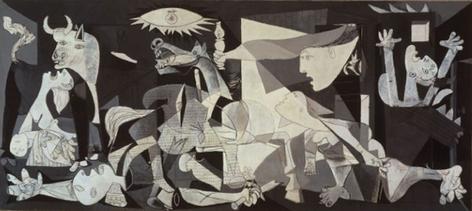

The first set of oil paintings I ordered arrived in February. I loved them. They’re now in my guest room and I can’t wait for my family from Idaho to come see them when they visit me in Indiana. So I ordered two more, just as rumblings of a Russian invasion of Ukraine were growing. I crossed my fingers, hoping they would arrive because Alexander had proven to be such a fast shipper.
Several weeks, a flood of immigrants, and thousands of casualties later, I doubt the paintings will reach me. And that’s okay. It’s nothing for me to be upset over in the face of such a catastrophe. But I did reach out to Alexander to see if he was safe, and for the time being, he said that he was. I hope and pray that remains the case.
***
I learned to love art at an early age, in large part because of a gift from my aunt: her college textbook, a great gray tome called “The Big Book of Art.” I was maybe 8 years old when she gave it to me, and inside was a survey of art from cave paintings to works produced at the book’s publishing in the 1960s. I was immediately pulled to the abstract works of the early twentieth century — bold and wild and unlike any art I had known before. So when I saw a work by Picasso called “Guernica”, I stopped in my tracks.

Picasso’s “Guernica” is a massive mural in black and white, and it is full of chaos and grief and torture in the eyes of the people and animals trapped in paint. It depicts the bombing of the Basque town of Gernika (which is the true, Basque spelling) in 1937. The civilians of this central town were bombed by the soon-to-be dictator of Spain, Francisco Franco, in cooperation with Hitler’s forces in an early experiment of the blitzkreig. Picasso painted the mural in response to the tragedy, where innocent lives were razed to the ground and a town was left to rubble.
My father was born and raised in the rebuilt city of Gernika. My godfather saw the planes flying and women yelling. My grandmother witnessed the planes as well, and had to house ground troops following the aerial assault. It was an attack on my people, and even though it took place years ago, so far away from my life in the American West, it was instrumental to my very existence.
I was captivated by Picasso’s rendering of the attack — it allowed me to see more of the experience than any of the photographs available could share. And even as a child, it revealed to me the power of art to speak great truths.
I’m now at a point in my life when I can start to buy original works of art from young artists, and it breaks my heart to see this stupid, unnecessary, brutal war stop the beauty of Alexander Konda and so many other artists, creators, and other makers in Ukraine. These two little paintings stuck in a post office are just a small illustration of that loss. Like spring flowers still blooming amidst the rubble of Kiev, these lost works serve as a reminder of how deeply incongruent this war is, how antithetical to what should be the natural order of peace. This shouldn’t be happening.
But if Picasso’s painting of “Guernica” — and the now thriving city of Gernika — has taught me anything, it’s that war can’t stop the power of art, the power of artists, the power of people to resist, rebuild, and renew. It almost feels trite to say this when planes are indiscriminately destroying theaters housing civilians, or shelters marked with the word “children” legible from the sky, but I have to have faith that beauty will reign over this ugliness, that art will flourish again, that the people of Ukraine will never be crushed by would-be dictators.
***
Perhaps Alexander Konda’s paintings will somehow arrive at my door someday. It’s okay if they don’t. What’s more important is that he stays safe to make more someday. What’s more important is that the West rallies to save Ukraine. What’s most important is that the people of Ukraine survive.
At the time of writing this, I’ve reached out again to Alexander to see if he’s safe, and if there’s anything he would want us in the West to know or do to support the people of Ukraine or their artists. I hope to share news from him soon.
UPDATE: On March 22, 2022, Alexander reached out to Javi with this message:






















.jpg)


.jpg)

